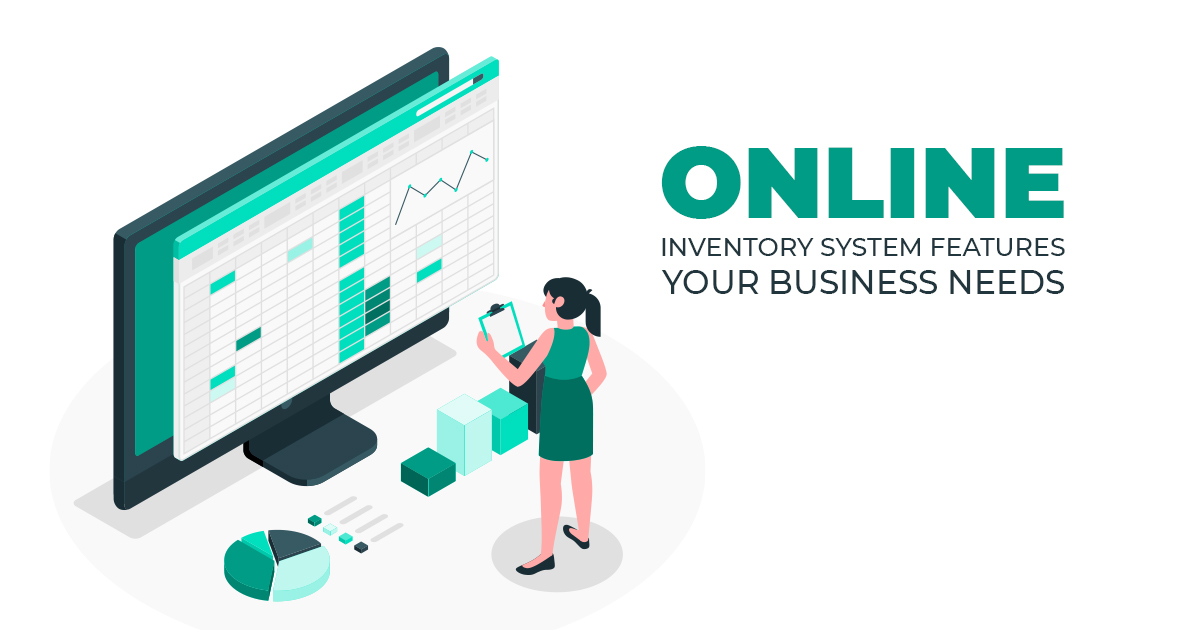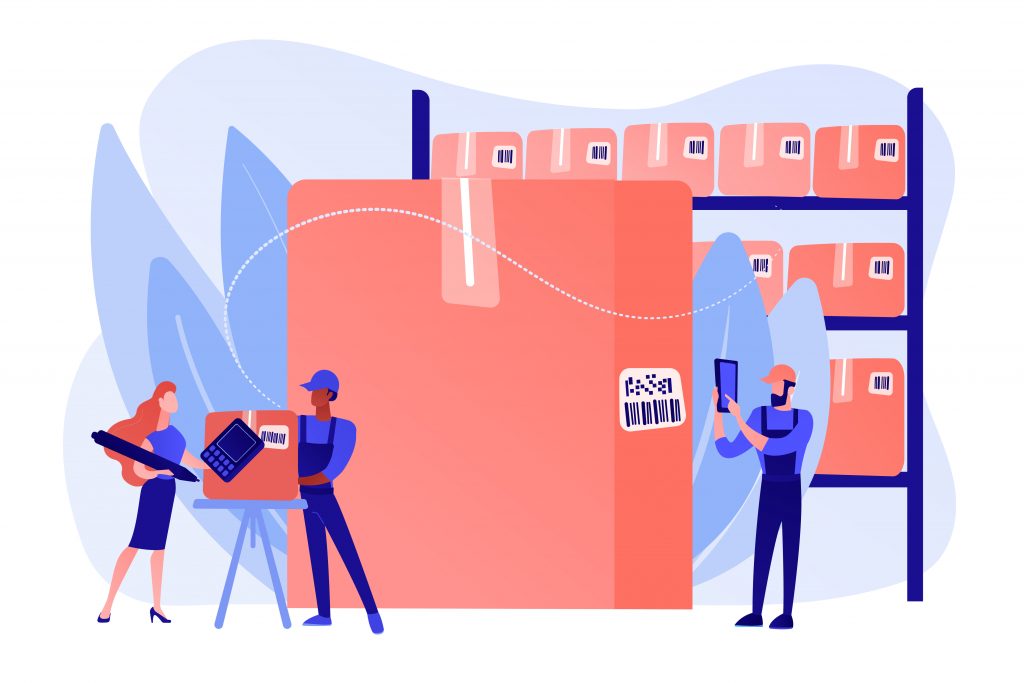
Why do businesses need online inventory systems?
You might think that pen and paper can suffice, but that’s acceptable for smaller businesses. However, businesses of all sizes have a lot to think about! So that’s why they need systems with online inventory system features.
Now, all businesses need online inventory systems, yet no two are exactly alike. Therefore, they need to tailor their inventory management system to the type of inventory they carry.
When you have an inventory system of your own, amounts or costs are determined with every order. So depending on the day, suppliers may raise or lower the prices of goods. As a business owner, you need to get ahead of the curve and make sure your company still retains some profit.
These methods are automated. But with online inventory system features, you can automate nearly every process from receiving the inventory to the sale and finally delivering to your customers!

Online inventory system features
The great thing about an online inventory system is that it can accommodate pretty much any transaction. Well, any transaction as long as it helps your business. For example, if you have an online system, you can monitor inventories across multiple branches or warehouses from just one application. You can even do this from the comfort of your home.
On the other hand, if you still stick with offline methods — doing things with pen and paper alone — you will find work time-consuming. Secondly, you will have to physically visit branches to see how they’re doing. Also, written records may have discrepancies. Finally, checking every stock and lot yourself will take time. This is why having an online system is more efficient.
So here are the online inventory system features your business needs.
Dashboard
The Dashboard usually shows the summary of the business’ health in a graphical presentation. So the information is summarized and presented in a way that’s direct to the point. You can see everything you need to know about sales performance, for instance.
Depending on the system, your Dashboard may display data using a line graph, a bar graph, or a pie chart. Also, there’s a section indicating the category of items sold. Additionally, information is filtered by location. From the Dashboard, you should see:
- Sales per Category
- Monthly Sales of the Year
- Inventory Reorder Report
- Sales Versus Cost Monitoring
Comparative Sales
Comparative Sales, also known as same-store sales, “indicate whether the company’s sales are increasing or decreasing over time.”
With this online inventory system feature, you can compare a month’s sales with another month or year. For example, you can check August’s sales from this year to August’s sales the previous year. This module helps you find discrepancies as well as trends.
Comparative Sales usually has the following details:
- Branches (if applicable)
- the Months and Years you want to compare.
Inventory Reorder Report
Additionally, your online inventory system can tell you what to purchase to make up for customer demand. An Inventory Reorder Report gives you the lowdown on your on-hand stock, purchase orders, and sales orders. Also, you can even see backorder reports through this module.
An Inventory Reorder Report is necessary to avoid having too much inventory (overstocking) or too little (understocking). Overstocking means you have more goods than your storage space can handle, but understocking will hit your sales more directly. But, if you’ve understocked for a product, people who came to look for it may avoid your branch to search for a place that has the product.
In this feature’s section, you will generally see:
- Branches (if applicable)
- Item Code
- Description
- Reorder Point
- Current Balance.
Purchase Order
Purchase Order is the documentation of an order to a supplier. Also, it “gives a complete understanding of what products or services you already provide.”
Purchase Orders are essential. They not only keep track of orders but also prevent duplicate orders. Additionally, they keep invoices in line. Also, Purchase Orders can help you out during financial audits as they are legal documentation.
Under Purchase Order are the modules:
- Purchase Order Monitoring
- Supplier Setting
Most companies document with the Purchase Orders. They require information such as:
- Purchase Order Number
- Date and Time
- Supplier Name
- TIN
- Address
- Code Number
- Item Name
- Classification
- Cost
- Quantity
- Amount.

Purchase Order Monitoring
Purchase Order Monitoring tracks your order from beginning to end, that is, the stocks’ arrival at your branch or physical store. Additionally, it tracks dates throughout the process. Therefore, it’s also called a Purchase Order Tracking System.
However, some expected deliveries may not arrive as planned. For instance, you expect a shipment to arrive in July, yet the system states it’s still en route. Or, a delivery only has the partial amount, rather than the amount that was originally ordered. A Purchase Order Monitoring system is essential to keep track of the purchases and delivery of goods. So this way, you can strategize the releases of your goods through sales based on the purchase delivery trend that you have per supplier. Additionally, this module can ensure that you replenish stock by the required date.
The PO Monitoring section generally needs details such as:
- Status
- Date
- Purchase Order Number
- Supplier
- Item Name
- Unit
- Balance
Receiving
Receiving is a module to record received goods from suppliers. Through Receiving, you can track your newly-arrived stock. In addition, it can register the total amount of goods received.
But, let’s say your business ordered 10,000 of a given item, yet you received quantities not level to the quantity order. So that means there’s a quantity receivable left in the Purchase Order. The seller can deliver a partial amount, provided they notify you first. Additionally, a good Receiving module allows you to record partially delivered goods from your supplier. Also, it’ll keep track of the remaining quantity to be received in real-time. That’s the best thing about an online inventory system! It’s dynamic and can fit different scenarios.
Receiving requires details like:
- Reference Number
- Date and Time
- PO Number
- Supplier
- Payment Type
- Due Date
- Code Number
- Item Name
- Unit
- Classification
- Cost
- Expiry Date
- Lot Number
- Quantity Left in PO
- Quantity
- Amount
- Purchases
- VAT Amount
- Total
- Discount
- Total Amount Due
- Down Payment
- Balance
Disbursements
On to Disbursements! This online inventory system feature allows users to settle dues from received goods and services from suppliers. A good disbursement module will let you pay multiple invoices in a single disbursement. It also allows for single disbursement with various payment options. Additionally, it allows for partial disbursement.
The disbursement section requires:
- Reference Number
- Date and Time
- Supplier Name
- Reference Number
- Payables
- Cost
- Quantity
- Amount
- Payment
- Check
- Cash.
Purchase Return
A purchase return allows your business to record returned purchases to your supplier. Therefore, the Purchase Return module makes it easy to adjust your records to consider the returned goods.
Though this may mean somewhat of a loss for the business, it’s not a total loss! Purchase returns keep you from selling low-quality goods to your customers. Still, it’s good to keep track of your purchase returns. A loss on this part is maybe with time. A purchase return means having an additional process, such as reviewing goods before sending them back to the supplier. But it is better to spend on returning goods than to lose customers due to wrong or damaged items delivered.
The online inventory system is one of your best resources to manage the return of purchased goods. Purchase returns occur for several reasons. So for Return Inventory, damaged or expired items are returned. Also, there’s Wrong Inventory, when the wrong item type is returned.
Purchase Returns require:
- Reference Number
- Date and Time
- Supplier Name
- Invoice Number
- PO Number
- Classification
- Unit
- Amount.
Releasing
Releasing is a module that holds all releasing transactions such as: Releasing for Sales, Releasing for Stock Transfer to other branches or locations, and Releasing for Purchase Return to suppliers. So in a nutshell, it is a general term used to release inventories in different ways.
Additionally, through this feature, you can record walk-in purchases. As a result, there’s no need to jot down every customer’s name. Instead, you record transactions by noting the cash and charges. The system can also handle calculations for the due date of debts, also known as the Accounts Receivable balance.
Sales
One of the standard online inventory system features is recording sales. Additionally, this online inventory system feature lets you record which seller sells a particular item. Also, monitoring sellers and salespersons is a cinch! You can also review agents’ performance.
Tracking sales is essential as it’s how you track your business’ progress. So, the information you record can show how your business is doing and what items are doing well. It also shows what items are selling poorly. The system will display all sales-adjacent information, such as transactions and recorded payments. Payment options such as single and multiple payments are necessary, as well.
Sales details required are:
- Reference Number
- Date and Time
- Salesperson
- Customer Name
- Payment Method
- Credit Limit
- AR Balance
- Variance
- Code Number
- Item Name
- Unit of Measurement
- Lot Number
- Expiry Date (if applicable)
- Price
- Quantity
- Amount
Sales Return
Sales return involves merchandise being sent back to the vendor or seller. Customers return items whenever they don’t get a product that’s up to standard. Usually, when customers have to return an item to a store, they need the invoice number and quantity of items. It’s why you need proof of purchase, just like a receipt.
A sales return means a bit of a loss for the company. However, it’s not all bad, as it allows you to reevaluate your stocks. Though you have to deal with the return by readjusting your records, you were at least able to rectify the mistake.
Sales Return details required are:
- Reference Number
- Date and Time
- Invoice Number
- Customer Name
- Salesperson
- Code Number
- Inventory Name
- Unit of Measure
- Cost
- Price
- Quantity to Return
- Quantity
- Amount
Inventory
Inventory Conversion
The Inventory module lets you convert inventory items from a higher unit to a much lower unit or vice versa.
So for some companies, inventory is their lifeblood. Therefore, effectively dealing with inventory is key to maximizing profits while minimizing waste. The key to offloading stock and gaining profit is to plan accordingly. The Inventory Conversion module can help you by automating the process.
The entire online system works in tandem to manage the inventory. Now when you receive goods, they’re generally in bulk. Yet, it’s only after converting them to smaller amounts that you can sell them easily.
The Inventory Conversion needs these details:
- Reference Number
- Date and Time
Item to be Converted needs details such as:
- Code Number
- Item Name
- Unit of Measurement
- Available Quantity
- Quantity to be Converted
- Cost
- Total
Also, Conversion Output needs these details:
- Code Number
- Item Name
- Unit of Measurement
- Expiry Date
- Quantity
- Cost
- Amount
Adjustments
Inventory needs to be adjusted whenever the need arises. Adjustments account for losses such as breakages and thefts. You must record anything that diminishes the condition of a product.
For example, let’s say that sacks of rice burst open during transport. So, you need to record the quantity of wasted rice as a deduction through the online inventory system. Fixing or covering for discrepancies in the system involves handling the inventory balance carefully. So, online inventory system features make it easier to process records of goods.
Details needed in Adjustments are:
- Reference Number
- Date and Time
- Code Number
- Item Name
- Unit
- Classification
- Expiry Date
- Balance Quantity
- Actual Quantity
- Cost
- Variance — Short
- Variance — Over.
Stock Transfer
Stock Transfer is the process of asking other branches for balances of their items to replenish stock.
So, a stock transfer is necessary for a branch to stay on top of demand. For instance, a branch is low on a particular type of stock. Still, asking for a new shipment of goods from suppliers can take time. On the other hand, other branches have an existing surplus ready for collection.
So, you need to input:
- Stock Transfer Number
- Date and Time
- Transferring Personnel’s Name
- Transferring Branch
- Location to Transfer to
- Code Number
- Item Name
- Unit of Measure
- Lot Number
- Expiry Date
- Quantity Transferred
- Quantity Received

Online inventory system features handle the little things
Handling inventory is no joke. It’s also not about putting boxes wherever. The business that keeps its stock in line will profit handsomely. If you’re handling materials that don’t have an expiry date, then maybe you can afford to slack a little. So this means every good business needs an online system. Online inventory system features can do whatever is required to assist you in managing your business. It helps one max out profits while making sure your processes are efficient.
Regardless of whether or not you’re a smaller business that has all stock in one room or you’re a business with multiple warehouses loaded with products, you need a good online inventory system.
